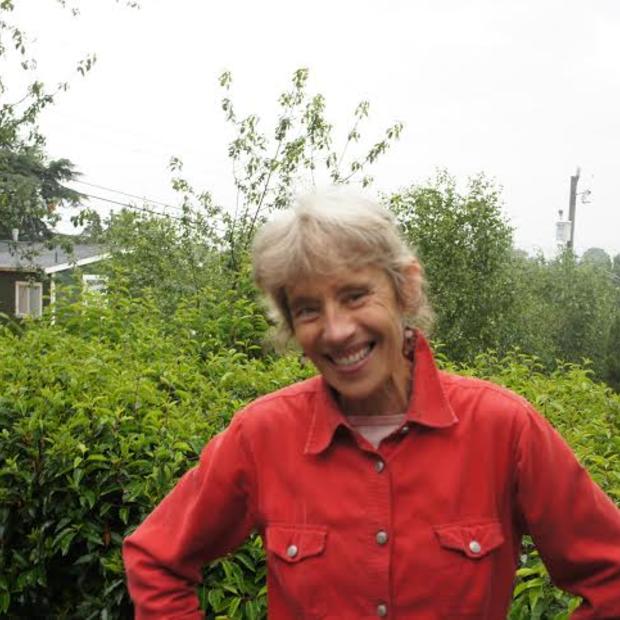High noon and the passengers in the back of Paula Bondo’s van are still asleep. As the weather warms, they’ll emerge from cocoons and their non-stop work will begin. From April to June they’ll collect nectar and pollinate one of every three bites of food Americans consume.
Bondo is part of a growing movement to raise bees in backyard gardens and increase their numbers. In this case, mason bees, so named because they build their nests using dabs of mud to pack around each egg. These gentle, solitary bees are pollinating powerhouses. One mason bee can do the pollinating work of 100 honeybees.
Bondo waits at a Park and Ride in Kirkland for her charges to be picked up by bee-raising partners. “That’s it, the bees and the house.” Bondo hands a wooden tray full of cocoons to a gardener.
Most gardeners and farmers are aware of the honey bee’s plight. After all, honeybees pollinate fruit blossoms and produce sweet amber honey. Colony collapse disorder, though, has decimated their numbers, forcing growers to turn to other pollinators for solutions. Pollinators, like the mason bee, less impacted by pesticides, disease and mono-crop growing methods without shrubs, flowers or cover crops.
Dave Hunter, president of the Orchard Bee Association, is owner of Crown Bees of Woodinville. He began to introduce mason bees to gardeners four years ago. Two and a half million of these gentle pollinators have been released nationwide. His goal is four billion. To reach it, he needs backyard gardeners willing to raise bees and supply cocoons to orchards.
"One backyard gardener might have four hundred cocoons," he explains. "Those four hundred cocoons in an orchard would handle a complete acre. So you’re going to get how many tons of cherries from that one gardener’s backyard? That’s the magic of what we’re doing.”
At Hunter’s bustling home office operation, hundreds of thousands of mason bee cocoons are removed from wooden trays and placed in PVC tubes for release locally or for shipment across the country. Each tube holds fifty to one hundred bees. “We’re having the gardeners release these just a little at a time. So, #1 tube will go out in a week or so, #2 a couple of weeks into April and #3 probably in late April.”

Photo: Dave Hunter
The tubes will be placed on specialty cylinder shaped houses made of reeds or paper, or on homemade houses made from logs with one-inch diameter holes. When temperatures rise, bee gardening partners will watch the bees come alive.
Margarite Margason began to attract mason bees after she heard about colony collapse disorder several years ago. She and her husband took a small log, drilled holes in it, placed it under an eastfacing eave of their house and watched. Within two days, tiny native black bees found the log. “And I was delighted. They were so shy. I mean, if they saw my head in the window they wouldn’t go into their little holes. So I found I had to conceal myself, peek around the curtain and then they felt safe to go in.”
Since then she’s welcomed mason bees to her garden every spring to pollinate and lay eggs during their short six week life span. Teaming up with Hunter allows her to play a part in growing the population she says, in order to reach 4 billion mason bee goal within five years.
The biggest challenge to increasing their numbers, says Hunter, is dispelling the myth that all bees sting. Honey and bumble bees are social. Their job is to protect the queen, the hive and the eggs. If people get in the way, there may be consequences. Mason bees, in contrast, are solitary.
“It’s just the female and she can stand there in front of her hole and guard it with her bazooka or she can go out and gather pollen and nectar and lay an egg and get mud. She can’t do both and so she doesn’t."

Hunter holds a mason bee. Photo: Dave Hunter
Hunter calls his project BEE-GAP — bee gardeners adding pollinators. It runs parallel to a grant he received from the USDA Specialty Crop Research Initiative to show growers the economic advantage of using managed bees like mason bees for five crops: apples, cherries, almonds, blueberries and melons.
There’s urgency to the work, says Hunter. The almond industry is already struggling to find enough honeybees. In five or six years orchards all over the US may not have enough. “So, if we can augment with native bees that the backyard gardeners have been raising, that’s the big picture.”
To date he has 3,800 bee-raising partners around the country and he’s looking for more gardeners to guarantee pollination. What do you need? A porch or eave that gets light, a chemical free garden with trees or flowers, mud or soil for the mason bee to make nests, and a house to keep them dry.
It only takes a few hours a year to handle and harvest the bees and the costs are minor, he adds.
For information or to sign up for monthly “bee-mails”, visit crownbees.com.


